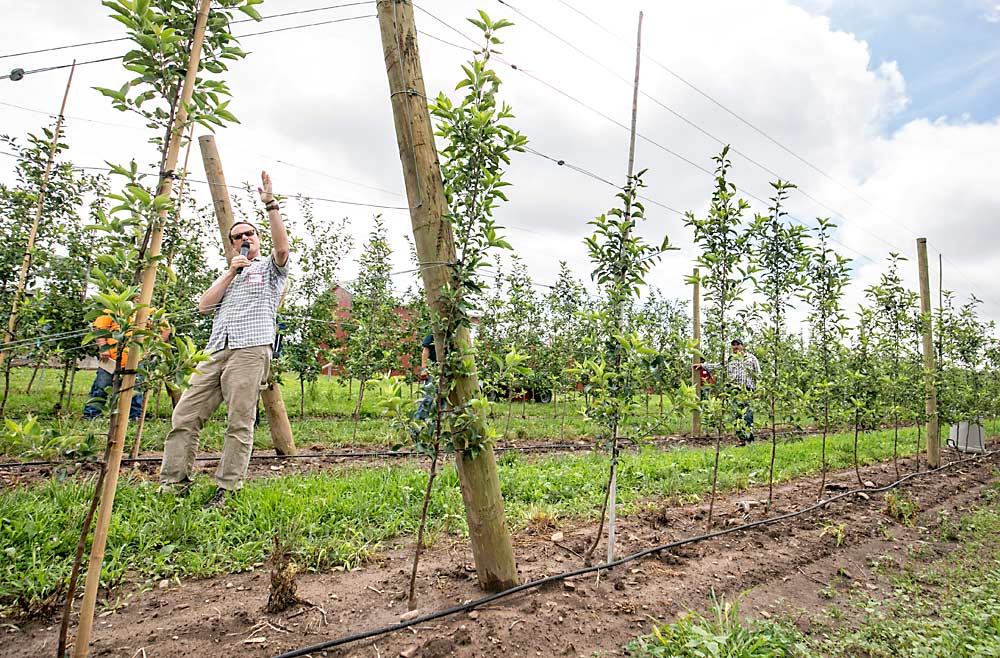
The first thing grower Mark Russell does after planting a new orchard block is chop off all the nice feathered branches on the nursery trees delivered from Washington.
“Everything that looks like a branch gets removed and everything that looks like a thin dard remains,” said Russell, who runs Two of Clubs Orchard in Niagara County, New York, with his wife, Jill MacKenzie. “We stub back, 4 to 6 inches from where the branches were, and then on the first hot day of spring we go out with a Maxcel spray on the trunks of the newly planted trees.”
That approach moves the fruiting wood closer to the trunk, and the lack of big branches helps the young trees grow the leader to fill space first, he said. It’s working — this spring they looked like pipe cleaners at bloom — but he’d rather buy a nursery tree that fits his system, replacing the six or seven feathers with several dozen little dards that can carry fruit in the second leaf, saving him a year of training.
Many growers face the same situation as they move to higher-density plantings, where the strong branches of a standard or knip-style tree don’t serve them as well as they used to, said Cornell University physiologist Terence Robinson. The desire for custom trees has pushed more growers in his area to set up their own nurseries.
Robinson said he had long discouraged home nurseries, because it requires serious attention to detail to produce good trees, but now he believes the “grow-through-tree” approach that leaves the trees to grow through an extra year in the nursery can pay off for growers willing to put in the extra nursery work.
The process starts with a bench-grafted tree, grown to 4 or 5 feet in the first year. In the second year in the nursery, side branches are all cut back to a two-finger-long stub, Robinson said. Then, in early May, they spray from knee-high to the tip with Maxcel (6-Benzyladenine) to induce spur branches. Then, the trees are pushed with water and nitrogen and four (or so) more Maxcel applications.
“The last and critical step is what we call pinching. Twice during June or July you have to walk that nursery and pinch back any branches that are going to be long,” he said. The result is short feathers instead of long ones, and the small regrowth is crowned with flower buds. “These short feathers allow us to maintain a more two-dimensional canopy,” he said.
Chip and Karla Bailey, owners of KC Bailey Orchards in Williamson, New York, began using this approach in 2016. Karla coined the term “instant orchard,” Chip said, when they started using commercial knipboom trees to fill space quickly. In 2016, they decided to start growing their own — thanks to prior nursery experience, they knew what they were getting into — to replace long feathers with more short ones.
“We go through the normal nursery cycle, but we keep the trees in the ground a third year, which helps us to put the fruiting units on the tree where we desire,” he said. That requires a pruning, Maxcel, nutrient and water program that’s just a lot easier to do in the nursery when trees are 1 foot apart than already planted out in the orchard, he said.
“That’s the big thing growing your own trees does provide; it allows you to customize what you want the orchard to look like,” Bailey said. His vision: cropping in the second leaf on trees planted at 2.5-foot spacing with 12 feet between rows. Planting 8-foot-tall nursery trees allows him to do that.
“Our goal is to fill in the space quickly,” he said, adding that irrigation is a must for planting these big trees. “The bills start immediately, so the cash flow needs to be there, too.”
Russell, for his part, said he’d rather leave the nursery work to the professionals. He just ordered custom trees from Washington nurseryman Dale Goldy for 2022 that he hopes will save him all that early training.
Such trees are now rare in commercial nursery production in the U.S., Goldy and Robinson said. There has been such high demand in recent years for standard trees, there’s been little incentive for innovation and customization. But if getting a different tree means getting orchards into production faster and more efficiently, that could start to change.
“There is not one nursery tree to solve everyone’s problems,” Goldy said. “We’ll have to get more adaptable than that.” •
—by Kate Prengaman
Related:
—An orchard with a head start






Leave A Comment